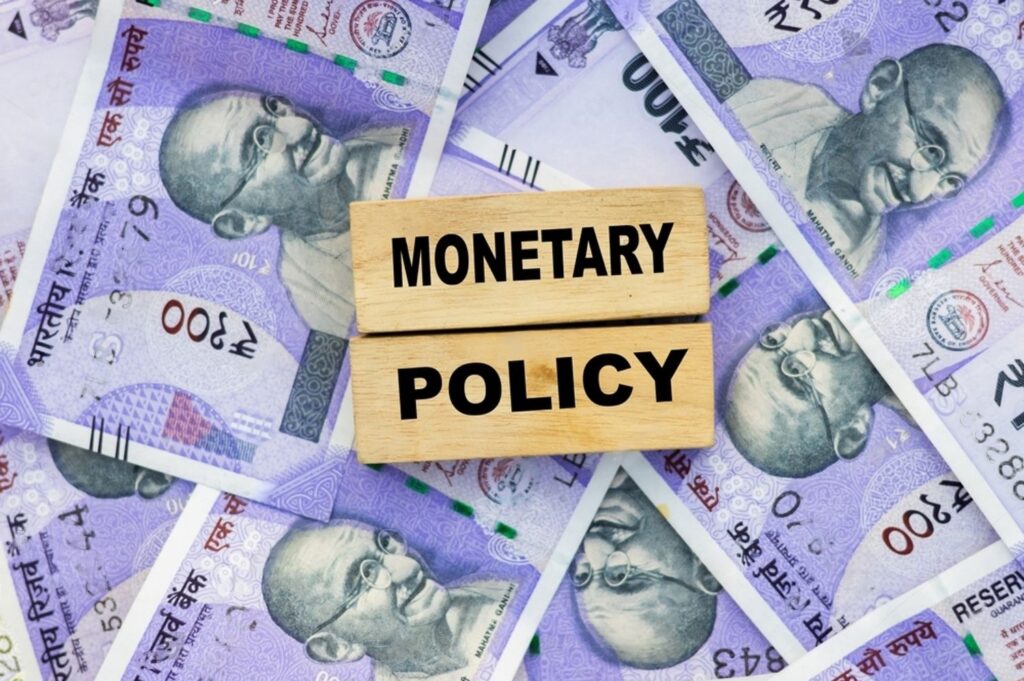Meaning of Monetary Policy
Monetary Policy of India, overseen by a country’s central bank or monetary authority, is the strategic regulation of the money supply and interest rates to achieve crucial economic objectives. These objectives include ensuring price stability, controlling inflation, fostering economic growth, and sustaining employment levels. Central banks employ tools like open market operations, discount rates, and reserve requirements to influence money supply and credit conditions, creating a conducive economic environment.
According to D.C. Rowan, monetary policy is a set of measures implemented by monetary authorities to regulate the money supply, interest rates, and money availability. These measures, aimed at specific economic goals, play a pivotal role in shaping an environment that supports stable prices and sustainable economic development.
Read More: New Monetary Policy of RBI

Main Objectives of Monetary Policy
India’s monetary policy is strategically designed to achieve essential goals, with a focus on promoting price stability, controlling inflation, and fostering economic growth. The key objectives of India’s monetary policy include:
- To Regulate Money Supply in the Economy: Monetary policy addresses the circulation of money and credit created by banks. It aims to align the supply of money with the demand in the economy by managing credit expansion and contraction.
- To Attain Price Stability: A primary focus is on ensuring price stability and managing inflation, as the price level is significantly impacted by the money supply. Regulating the money supply helps prevent significant fluctuations in prices.
- Promoting Economic Growth: Monetary policy plays a crucial role in providing the necessary currency and credit for economic development. It ensures that areas essential for economic growth receive an appropriate amount of currency and credit.
- Promoting Saving and Investment: By regulating interest rates and controlling inflation, monetary policy encourages savings and investment. Higher interest rates promote saving, while lower rates encourage investment.
- To Control Business Cycles: Monetary policy aims to manage different stages of the business cycle, such as boom and recession. Credit is tightened during booms to control inflation and expanded during recessions to stimulate aggregate demand.
- To Achieve Stability in the External Value of Rupee: The Reserve Bank works to stabilize the exchange rate of the rupee with major foreign currencies, influencing demand and supply through buying or selling foreign currencies.
- To Manage Aggregate Demand: Monetary policy balances aggregate demand and supply of goods and services. Credit expansion and interest rate adjustments are utilized to boost or moderate demand based on economic conditions.
- To Ensure More Credit for the Priority Sector: Efforts are directed towards providing more credit to priority sectors, including agriculture, small industries, and weaker sections of society. Concessional interest rates are applied to loans in these sectors.
For a deeper understanding of India’s monetary policy and its impact on economic dynamics, explore the related article on the problem of unemployment in India.
Read More: Economic Reforms in India
Measures of Monetary Policy of India
- Techniques for Currency Expansion: The Reserve Bank of India has a monopoly on issuing currency. This bank can issue any quantity of notes based on gold and foreign securities worth ₹200 crore, with at least ₹115 crore in gold value. In 1951, ₹1,420 crore worth of notes were in circulation, and this value increased to ₹28,81,115 crore in December 2021.
- Techniques for Credit Control: Besides currency, the amount of credit in circulation is a crucial component of the economy. The Reserve Bank has implemented various measures for credit control, using both quantitative and qualitative techniques. To reduce the inflation rate, various credit control techniques have been employed, ensuring sufficient credit is available for economic development.
Instruments of Monetary Policy
Restriction is a crucial function of monetary policy, involving the expansion and contraction of credit to meet the economy’s needs, known as credit control. The Reserve Bank employs various credit control measures, categorized into quantitative and qualitative methods.
1. Quantitative Credit Control
Understanding Quantitative Credit Control is essential for comprehending the Reserve Bank’s strategic influence on lending rates and overall credit conditions. Here’s a breakdown of key tools employed:
- Bank Rate (Discount Rate): The Bank Rate, or discount rate, is a pivotal tool shaping lending rates. An increase signals other banks to raise lending rates, leading to credit contraction. This strategic move regulates the availability of credit in the financial system.
- Statutory Liquidity Ratio (SLR): SLR dictates the percentage of deposits banks must keep as liquid assets. Adjusting the SLR directly impacts funds available for loans. An increase tightens credit conditions by reducing the pool of funds for lending.
- Open Market Operations: These involve buying and selling government securities. Buying injects money, expanding credit, while selling absorbs money, contracting credit. Open Market Operations play a crucial role in managing liquidity and credit conditions.
- Cash Reserve Ratio (CRR): CRR is the percentage of deposits banks must keep with the Reserve Bank. A higher CRR reduces funds available for lending, providing a mechanism to control the lending capacity of commercial banks.
- Repurchase (Repo) and Reverse Repo Rates: Repo rate influences borrowing costs for banks, contributing to a credit crunch when increased. Reverse Repo rate encourages banks to deposit more funds, reducing their lending capacity.
- Multiple Interest Rates: The Reserve Bank sets various interest rates through its monetary policy, creating credit quotas for banks. This ensures controlled and stable credit distribution, aligning with monetary policy objectives.
Read More: Monetary Policy of India
2. Selective or Qualitative Credit Control
Selective or Qualitative Credit Control, a method tailored for specific areas or products with a targeted impact. This discriminatory approach, not uniformly applied to the entire economy, allows for nuanced intervention. For example, if wheat prices surge, the Reserve Bank can instruct banks to refrain from lending money with wheat as security. This targeted negative credit control reduces demand and lowers the price of the specific commodity, showcasing its selective nature.
- Changes in Margin Requirements on Loans: Margin adjustments, representing the difference between market value and loan value, impact credit extension. Priority sector loans with lower margins are influenced by changes. Increasing the margin limits new credit on securities, while reducing it allows more credit on weaker securities.
- Moral Persuasion: The Reserve Bank employs moral influence, advising commercial banks to minimize non-priority and unproductive debts. This qualitative method aligns with ethical considerations to shape lending behavior.
- Credit Authorization Scheme: For credit limits exceeding ₹6 crore for a single borrower, the Central Bank seeks authorization from the Reserve Bank. Initiated in 1988, this scheme ensures scrutiny for large credit transactions.
- Credit Monitoring Arrangement: Commercial banks extending loans exceeding ₹5 crore for working capital undergo investigation by the Reserve Bank. This arrangement ensures a watchful eye on significant credit transactions.
- Direct Action: According to the Banking Regulation Act of 1949, the Reserve Bank can halt any transaction. Non-compliance with the credit policy can lead to direct action against non-compliant banks.
- Revised System for Delivery of Bank Credit: Implemented in 1995 for loans of ₹20 crore or more, this system regulates credit for substantial borrowers, ensuring a structured and controlled approach.
- Ceiling on Loans: The banking sector’s maximum loan limit for any single project is capped at ₹500 crore, offering a safeguard against excessive lending.
Read More: Economic Planning in India

Limitations of the Monetary Policy of India
India’s monetary policy encounters several limitations that impact its effectiveness in economic management. Understanding these constraints is crucial:
- Limited Economic Development Impact: The scope of monetary policy in driving economic development is confined. It primarily focuses on credit control, while decisions related to money supply fall under the Finance Ministry’s jurisdiction, limiting the Reserve Bank’s control over money supply dynamics.
- Constrained Role in Inflation Control: The Reserve Bank’s role in controlling inflation is restricted, influenced by various factors beyond monetary policy. Adverse supply-side conditions, such as reduced production, make monetary policy less effective in addressing inflation.
- Impact of Poor Banking Habits: Prevalent poor banking habits, including a preference for cash over cheques, hinder credit creation. This weakens the implementation of monetary policy, limiting its efficacy in shaping economic activities.
- Challenges from Underdeveloped Money Market: An underdeveloped money market poses challenges to the effectiveness of the Reserve Bank’s monetary policy, especially in the unorganized sector. Functioning mainly in an organized money market, it struggles to address issues in the broader economic landscape.
- Disruption from Black Money: The presence of black money disrupts economic functioning, operating outside the accounting system. This poses a challenge in accurately determining money supply according to monetary policy objectives.
- Conflicting Economic Objectives: Monetary policy faces challenges in harmonizing conflicting objectives. Balancing the need for economic development, which requires expanding the money supply, with the demand for price stability, demanding contraction, proves to be a complex task.
- Lack of Fiscal Policy Coordination: Monetary policy lacks coordination with fiscal policy, especially in deficit financing. The Reserve Bank’s printing of more notes for government loans impacts the money supply without monetary policy control.
- Limitations of Monetary Instruments: Inherent limitations of credit control measures, such as high margin rates, CRR, and SLR limits, can impact banks’ profitability and increase risks, hindering the smooth operation of monetary policy.
- Influence of Non-Monetized Sector: The non-monetized sector, operating on barter exchange, remains unregulated by monetary policy. Unethical practices persist, diminishing the effectiveness of monetary policy in regulating economic activities in this sector.
Read More: Main Features of Indian Economy
Suggestions for Improvement in Monetary Policy
Unlocking the full potential of India’s monetary policy requires strategic improvements. Consider these suggestions for optimization:
- Prioritize Price Stability: Elevate the primary goal of the Reserve Bank’s monetary policy to achieve and maintain price stability. Align credit regulation with the objective of fostering stable prices in the economy.
- Enhance Monetary and Fiscal Policy Coordination: Foster enhanced coordination between monetary and fiscal policies. Collaborative efforts will amplify the effectiveness of both policies in achieving their respective objectives, fostering a harmonized economic landscape.
- Autonomy in Interest Rate Determination: Grant banks the autonomy to set interest rates based on prevailing market conditions. Allowing flexibility in interest rate determination enables a responsive approach to the dynamic financial environment.
- Fortify the Money Market: Reinforce and restructure India’s money market to attract increased investor engagement in the trading of government and Reserve Bank securities. A robust money market is pivotal for overall economic stability.
- Implement Monetary Targeting: Proactively establish an annual target for increasing the money supply, subject to regular evaluations. Adjust the target based on evolving credit needs, aligning with the dynamic economic landscape.
- Align Credit Planning with Economic Priorities: Ensure credit budgeting aligns with regional distribution based on economic priorities. Provide clear guidance on credit allocation across sectors like agriculture, industry, and services. Commercial banks must adhere to these directives for efficient credit distribution.
- Rigorous Implementation and Monitoring: Emphasize rigorous implementation of monetary policy objectives. Enforce strict measures against commercial banks deviating from Reserve Bank instructions. Regular checks should be conducted to ensure adherence and allow timely intervention when necessary.
FAQ on Monetary Policy of India
What is Monetary Policy?
Monetary policy is the set of measures by monetary authorities aimed at regulating (a) the money supply, (b) the cost of money or the interest rate, and (c) the availability of money to achieve specific economic objectives.
What are the main Objectives of Monetary Policy?
- To Regulate the Money Supply in the Economy
- To Attain Price Stability
- To Promote Economic Growth
- To Promote Saving and Investment
- To Control Business Cycles
- To Achieve Stability in the External Value of Rupee
- To Manage Aggregate Demand
- To Ensure More Credit for the Priority Sector
How to Measures of Monetary Policy of India?
- Techniques for Currency Expansion: The Reserve Bank of India has a monopoly on issuing currency. This bank can issue any quantity of notes based on gold and foreign securities worth ₹200 crore, with at least ₹115 crore in gold value.
- Techniques for Credit Control: Besides currency, the amount of credit in circulation is a crucial component of the economy. The Reserve Bank has implemented various measures for credit control, using both quantitative and qualitative techniques.
What are the Instruments of Monetary Policy?
1. Quantitative Credit Control
- Bank Rate: The Bank Rate, also known as the discount rate, is a tool used by the Reserve Bank to influence lending rates in the economy.
- Statutory Liquidity Ratio (SLR): The Statutory Liquidity Ratio (SLR) stands as a regulatory requirement dictating a percentage of deposits that banks must maintain in the form of liquid assets.
- Open Market Operations: Open Market Operations involve the buying and selling of government securities by the Reserve Bank.
- Cash Reserve Ratio (CRR): The Cash Reserve Ratio (CRR) is the percentage of total deposits that banks are required to keep with the Reserve Bank in the form of reserves.
- Repurchase (Repo) and Reverse Repo Auction Rates: The Repo rate is the interest rate at which commercial banks can borrow funds from the Reserve Bank.
- Multiple Interest Rates: The Reserve Bank, through its monetary policy, sets different interest rates, effectively creating credit quotas for all banks.
2. Selective or Qualitative Credit Control
- Changes in Margin Requirements on Loans: The margin is the difference between the market value and loan value, and it varies for different types of loans.
- Moral Persuasion: The Reserve Bank employs moral influence, advising commercial banks to minimize non-priority and unproductive debts.
- Credit Authorization Scheme: Before approving credit limits exceeding ₹6 crore for a single borrower, the Central Bank seeks authorization from the Reserve Bank.
- Credit Monitoring Arrangement: If a commercial bank extends a loan exceeding ₹5 crore to a single party for working capital, it must be investigated by the Reserve Bank.
- Direct Action: According to the Banking Regulation Act, of 1949, the Reserve Bank can halt any transaction
- Revised System for Delivery of Bank Credit: Applicable to loans of ₹20 crore or more, this system, implemented in 1995, aims to regulate credit for substantial borrowers.
- Ceiling on Loans: The banking sector’s maximum loan limit for any single project is capped at ₹500 crore.
What are the Limitations of the Monetary Policy of India?
- Limited Scope of Monetary Policy in Economic Development: Monetary policy’s impact on the country’s economic development is constrained.
- Limited Role in Controlling Inflation: The Reserve Bank’s monetary policy has had a restricted role in controlling inflation.
- Poor Banking Habits: Banking habits in India are lacking. Many people prefer using cash over cheques, hindering banks’ ability to create credit. This weakens the implementation of monetary policy.
- Underdeveloped Money Market: The underdeveloped money market limits the effectiveness of the Reserve Bank’s monetary policy.
- Existence of Black Money: The presence of black money disrupts economic functioning, as it operates outside the accounting system. This makes it challenging to determine money supply according to monetary policy.
- Conflicting Objectives: Monetary policy faces a limitation in its conflicting objectives. Economic development requires expanding the money supply, while price stability demands contracting the money supply.
- Lack of Coordination with Fiscal Policy: Monetary policy lacks coordination with fiscal policy, especially in deficit financing.
- Limitations of Monetary Instruments: The inherent limitations of various credit control measures pose challenges.
- Non-Monetized Sector: The non-monetized sector, operating on barter exchange, is not regulated by monetary policy.


[…] Read More: Monetary Policy of India […]